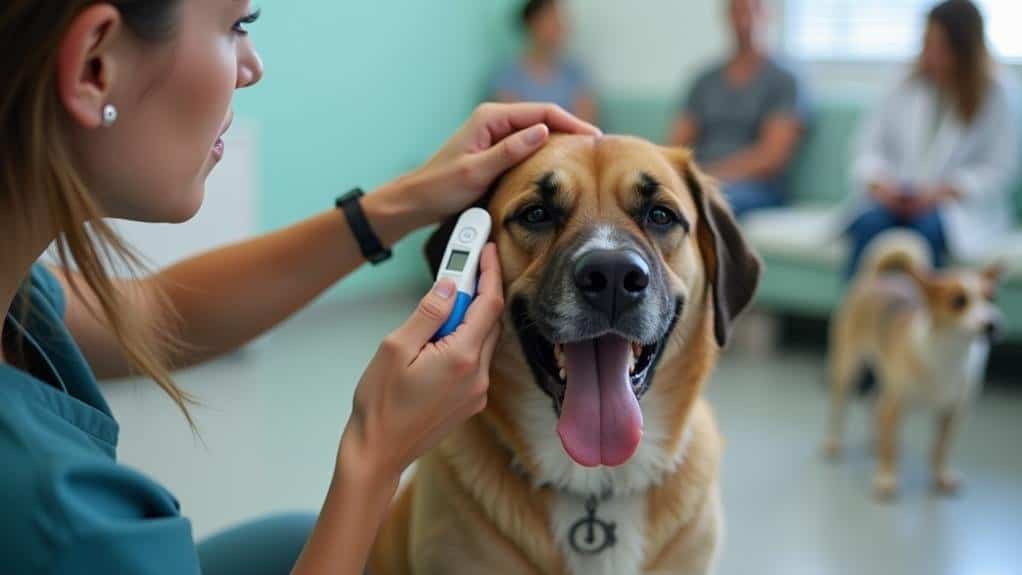Your dog’s hot head can be caused by various factors, including normal temperature fluctuations, increased blood flow from panting, or environmental heat.
While a dog’s normal body temperature ranges from 100.5°F to 102.5°F, the head may feel warmer. However, it could also indicate overheating, fever, or stress.
Check for signs like excessive panting, lethargy, or disorientation. Measure your dog’s temperature rectally for accuracy, and provide cool water and shade if needed.
If your dog’s temperature exceeds 103°F or symptoms persist, consult a veterinarian.
Understanding breed-specific traits and monitoring can help you better manage your furry friend’s well-being.
Normal Canine Body Temperature

Understanding your dog’s normal body temperature is vital for monitoring their health. Dogs typically have a higher average body temperature than humans, ranging from 100.5°F to 102.5°F (38.0°C to 39.2°C).
This normal body temperature can fluctuate due to various factors, including age, breed, activity level, and environmental conditions.
It’s important to recognize that canine body temperature isn’t static. Your dog’s temperature may rise slightly after exercise or during stressful situations. However, if it exceeds 103°F (39.4°C), you should seek veterinary care, as this could indicate underlying health issues.
To accurately measure your dog’s temperature, use a rectal thermometer. This method provides the most reliable results and can help you detect any concerning temperature fluctuations.
Regular monitoring is particularly significant during illness or after vaccinations.
Remember that temperature regulation in dogs is complex and influenced by various environmental factors. By familiarizing yourself with your dog’s normal temperature range and understanding potential causes of fluctuations, you’ll be better equipped to recognize when something might be amiss with your furry friend’s health.
Causes of Hot Head

A dog’s hot head can stem from various causes, ranging from normal temperature regulation to potential health concerns. When your dog pants, increased blood flow to the head helps regulate body temperature, making it feel warm to the touch. This is a natural response to heat and shouldn’t cause alarm.
However, a hot head can also indicate fever, often resulting from infections. If your dog’s temperature reaches between 103°F and 106°F, it’s time for a veterinary check-up. Elevated temperatures may also point to dental issues or abscesses, as inflammation in these areas can create localized heat.
Don’t overlook the impact of stress and anxiety on your dog’s temperature. These emotional states can trigger physiological responses, leading to a hot head along with other distress symptoms.
Environmental factors play a significant role too. High ambient temperatures or direct sunlight exposure can cause your dog to overheat, resulting in a hot head. Be mindful of your dog’s surroundings and provide adequate shade and water during hot weather.
If you’re concerned about your dog’s hot head, monitor for additional symptoms and consult your veterinarian for proper diagnosis and treatment.
Signs of Overheating

While a hot head can be a sign of overheating, it’s important to recognize other indicators that your dog may be struggling with excess heat. One of the most common signs is excessive panting, which is your dog’s primary method of cooling down. If you notice your dog panting more than usual, it could indicate an increase in body temperature.
Normal body temperature ranges for dogs are between 100.5°F and 102.5°F. If your dog’s temperature exceeds 103°F, it may suggest overheating or that your dog has a fever.
Other potential causes for concern include flushed ears and gums, which appear redder than usual as your dog’s body attempts to dissipate heat.
Symptoms such as lethargy, disorientation, and decreased responsiveness are also warning signs that your dog is overheating. In severe cases, you might observe drooling, vomiting, diarrhea, or loss of appetite.
If you notice any of these signs, especially in combination with a dog’s head that feels hot, it’s essential to take immediate action. Cool your dog down gradually and consult a veterinarian if symptoms persist or worsen.
Measuring Dog Temperature

To accurately assess your dog’s health, you’ll need to measure their temperature. Dogs’ normal body temperature ranges from 100.5°F to 102.5°F (38.0°C to 39.2°C). Measuring their temperature can help identify potential health issues, but it’s important to use the right tools and techniques.
Rectal thermometers provide the most accurate assessments of your dog’s internal body temperature. While digital ear thermometers are convenient, they may not offer the same precision. When using a rectal thermometer, make certain it’s specifically designed for dogs and follow proper hygiene practices.
Your dog’s temperature can fluctuate due to various factors, including age, breed, activity levels, and environmental conditions. Regular monitoring is vital to detect abnormalities and establish a baseline for your pet.
Keep in mind that a dog’s head will feel warm to the touch, but this isn’t a reliable indicator of their overall body temperature.
If you notice any significant temperature fluctuations or your dog exhibits symptoms like lethargy or loss of appetite, it’s important to consult with a veterinarian. While fever is a common cause of elevated temperature, other underlying health issues may be present.
Home Care for Hot Dogs

Caring for a dog with an elevated temperature requires prompt attention and careful management at home. If your dog’s head feels hot to the touch, it’s essential to provide a comfortable environment with access to fresh water and shade to prevent dehydration and overheating.
Monitor your dog’s behavior closely for signs of concern, such as lethargy, vomiting, diarrhea, or excessive panting, which may necessitate veterinary attention.
To help lower your dog’s body temperature, apply cool, wet towels to their ears and paws. However, discontinue this method once their temperature drops below 102.7°F (39.3°C).
Regularly check your dog’s temperature using a rectal thermometer; the normal range is between 100.5°F and 102.5°F (38.0°C – 39.2°C).
For proper evaluation and treatment, seek veterinary care if your dog’s condition doesn’t improve or worsens.
To prevent future incidents, avoid strenuous exercise during peak heat hours and guarantee routine check-ups.
When to Consult a Veterinarian

Although home care can often suffice for minor temperature fluctuations in dogs, there are situations when professional veterinary intervention becomes essential.
If your dog’s head feels excessively hot and is accompanied by symptoms such as lethargy, loss of appetite, or unusual behavior, it’s time to consult a veterinarian. These signs may indicate underlying health issues that require prompt attention.
You should seek veterinary care if your dog’s temperature exceeds 103°F (39.4°C) consistently, as this could lead to potential complications from fever or overheating.
Signs of dehydration, like dry gums and sunken eyes, also warrant immediate consultation.
If your dog experiences severe symptoms such as vomiting, diarrhea, difficulty breathing, or signs of pain after displaying a hot head, don’t hesitate to seek urgent veterinary attention.
Preventing Heat-Related Issues

While knowing when to seek veterinary care is important, proactively preventing heat-related issues can save your dog from discomfort and potential health risks. To keep your furry friend safe, make sure they always have access to fresh water. This helps maintain hydration and helps regulate their body temperature, especially during hot weather.
Create shaded areas for your dog and avoid outdoor activities during peak sun hours to minimize the risk of overheating. On hot days, limit exercise intensity and duration, opting for cooler morning or evening walks instead. This prevents excessive heat buildup in your dog’s body.
Regularly monitor your dog’s temperature, aiming to keep it within the normal range of 100.5°F to 102.5°F. This allows you to catch any potential heat-related issues early.
Additionally, prioritize routine check-ups with your veterinarian to identify and address any underlying health issues that may make your dog more susceptible to overheating or temperature fluctuations.
Breed-Specific Temperature Considerations

For dog owners, understanding breed-specific temperature considerations is essential. Different breeds exhibit unique canine temperature patterns, which can affect their susceptibility to overheating and temperature fluctuations.
Brachycephalic breeds, like Bulldogs and Pugs, are particularly prone to elevated head temperatures due to their short nasal passages. This makes them more vulnerable to overheating during warm weather or intense activity.
Larger breeds, such as Great Danes and Mastiffs, may have higher baseline body temperatures, causing their heads to feel warmer even when healthy.
Smaller breeds like Chihuahuas and Dachshunds experience quicker temperature fluctuations due to their higher metabolic rates. This can impact their head temperature during stress or exercise. It’s important to monitor these breeds closely in various environments.
Age-related health conditions can affect temperature regulation in older dogs of any breed, potentially leading to a warmer head.
Additionally, certain breeds have unique thermal tolerances. For example, Siberian Huskies, adapted to colder climates, may show signs of heat stress more quickly in warm environments, affecting their head temperature.
Frequently Asked Questions
What Does It Mean When Your Dog’s Head Is Hot?
Your dog’s hot head could indicate a mild fever or overheating. It’s often due to environmental factors, exercise, infections, or stress. Monitor their temperature closely and watch for other symptoms like excessive panting or lethargy. Provide cool water and environment.
Can You Tell if Your Dog Has a Fever by Feeling His Head?
You can’t reliably tell if your dog has a fever by feeling their head. While it may feel warm, it’s not an accurate indicator. Instead, use a rectal thermometer for precise readings and watch for other symptoms.
What Is a Dog’s Normal Head Temperature?
Your dog’s normal head temperature isn’t specifically measured. It’s usually slightly warmer than their body temperature, which ranges from 100.5°F to 102.5°F. You’ll feel warmth, but it shouldn’t be excessively hot to touch.
Should I Be Worried if My Dog Feels Hot?
You should be concerned if your dog feels hot. Check their temperature; if it’s above 103°F, they may have a fever. Watch for other symptoms like lethargy or vomiting. If you’re worried, it’s best to consult your vet.
Conclusion
You’ve learned about your dog’s normal temperature range and potential causes for a hot head. Remember to monitor your pup for signs of overheating and know how to measure their temperature properly. Provide home care when needed, but don’t hesitate to consult a vet if you’re concerned. Take steps to prevent heat-related issues and be aware of breed-specific considerations. By staying informed, you’ll keep your furry friend comfortable and healthy.

